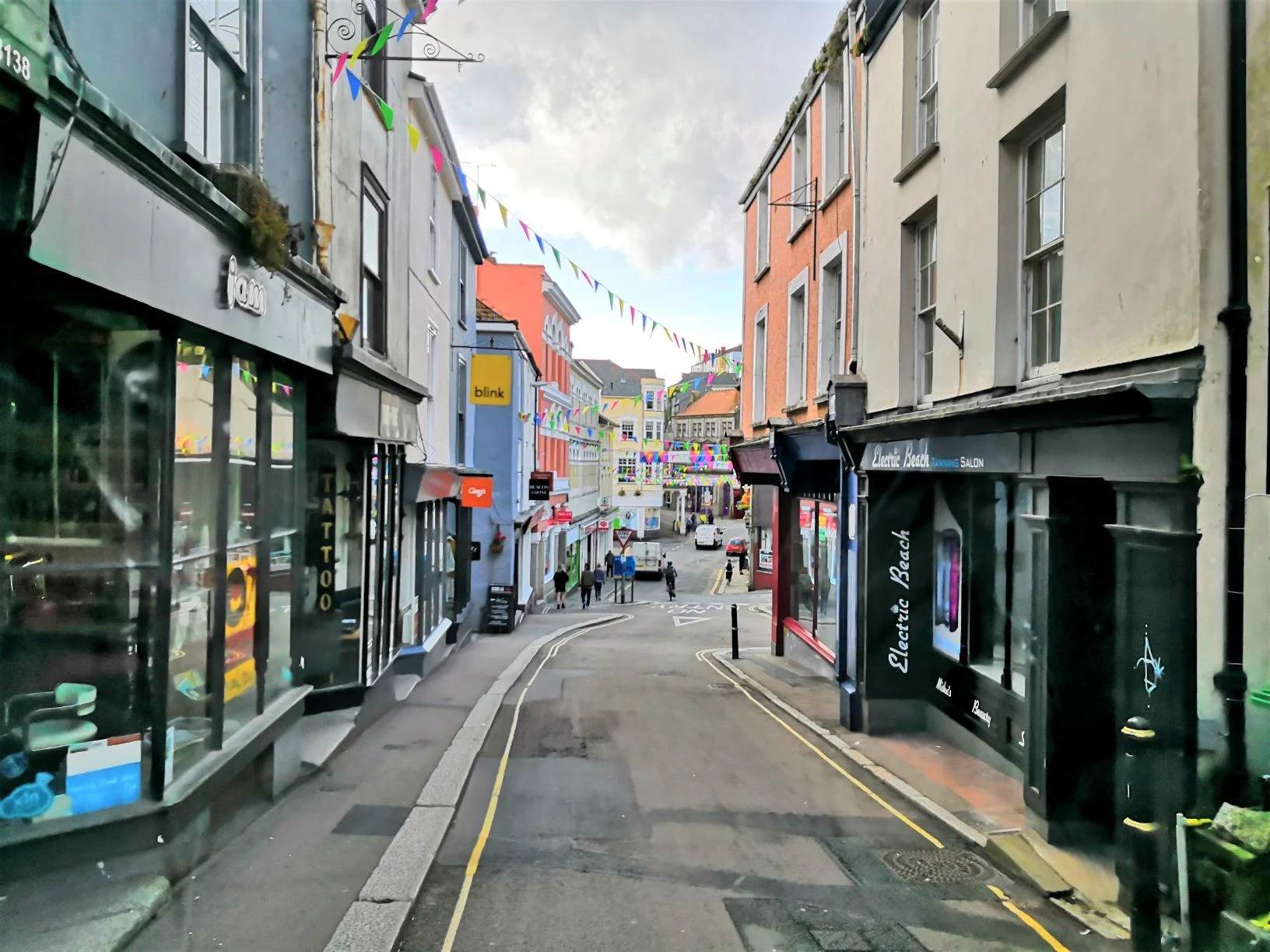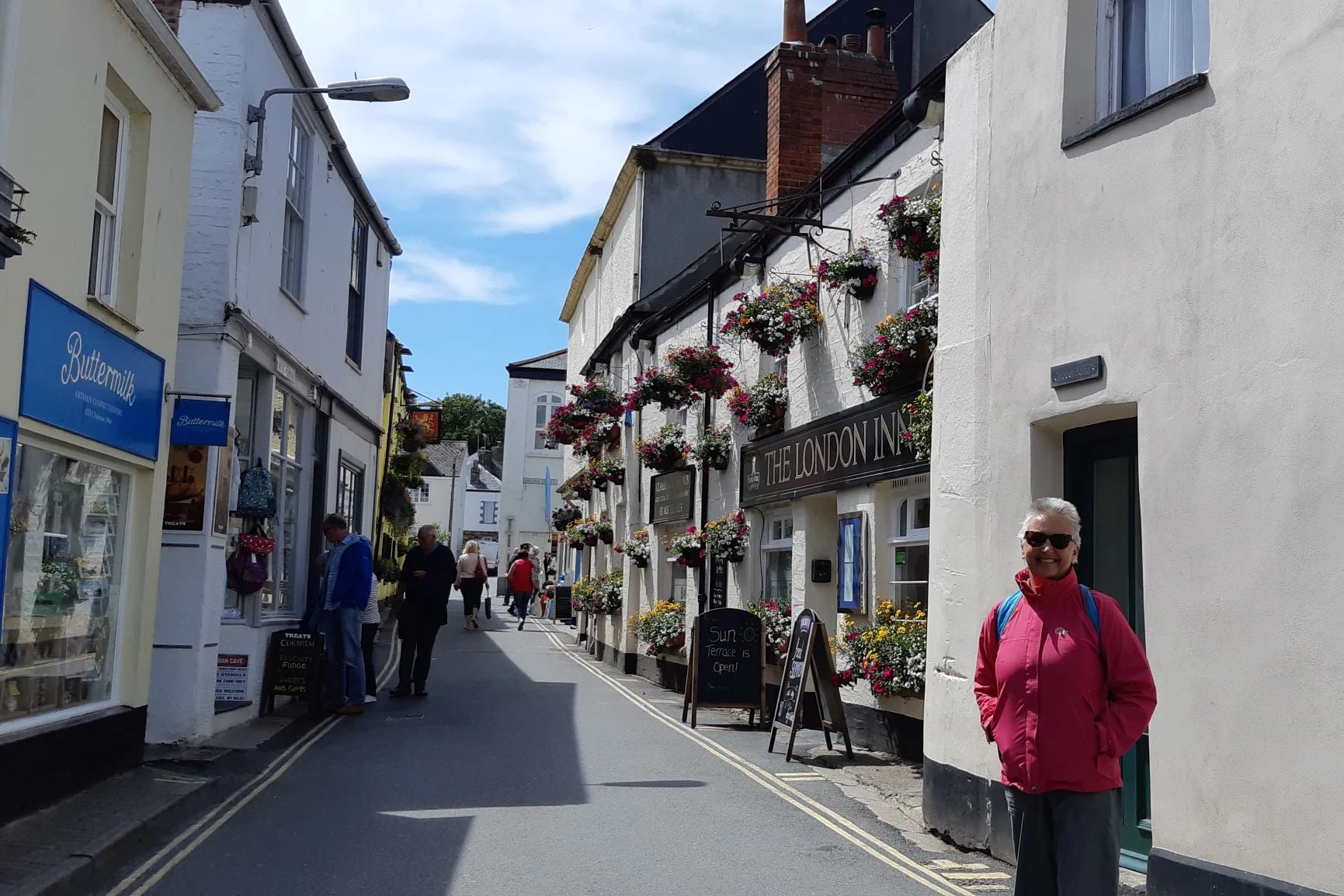Driving out of Plymouth (Devon) in our motorhome Vtee, put us in Cornwall. Our route through Cornwall will take us around the coast, through the Cornwall Area of Outstanding Natural Beauty (AONB). An AONB is a protected area of "stunning and diverse landscapes", so we were looking forward to seeing some picturesque places.
 |
| Marg in beautiful Polperro, Cornwall |
Our first stop in Cornwall was Polperro, a 12th century smuggling and fishing port. It has been named one of the UK’s most beautiful villages.
There is restricted vehicle access into Polperro and limited parking at the village entrance. So we drove to Looe, a village above Polperro, to park our big motorhome. Then we walked around 1-mile downhill into Polperro village.
It really is a beautiful village, with narrow winding streets going down to the port, small fisherman cottages with slate roofs, and a tidal harbour.
The tide was out when we were there and the fishing boats were all squatting comfortably on the mud flats, awaiting the incoming tide.
After exploring the village, we had Devonshire tea in a little tea house, and thought it was a delightful place to visit. Then just as we were leaving, it suddenly started to rain quite heavily.
 |
| Polperro, pretty even on a wet day |
We found a little electric bus that took us up to the top of the village to the car park, but our motorhome Vtee was still another mile away uphill in Looe, and the rain was getting heavier!
So Leigh flagged down a car that was leaving the car park and asked for a lift. Those lovely people took us right up to Vtee so that we didn’t get wet.
Heading off again, our next stop was the Eden Project in St Austell.
This is an initiative that uses geodesic biodomes, to house and nurture plants that have been collected from many diverse climates and environments around the world. It was an interesting place.
Leaving there, we drove to Charlestown, a mining village in the Cornwall and West Devon Mining Landscape, which is a UNESCO World Heritage site. Charlestown has an historic late-Georgian working port that we enjoyed visiting.
The port was constructed between 1791 and 1801 to support the growing local mining industry. More recently it has become home to a fleet of Square Rigger ships. Beyond the port, is quaint Charlestown village with its several Georgian cottages.
Very soon after that, and after a long day of driving and sightseeing, we arrived at Truro, our destination
for the next few nights.
We were in Truro, because it’s where
Marg’s Grandfather on her Dad’s side came from. The family left Truro to sail
to New Zealand in 1874.
From our Truro camping ground, we grabbed a bus into Truro city, enjoying the drive through the maze of residential streets on the way. Getting closer to the city centre, we spotted Truro cathedral with its impressive spires. We learned later, that you can see it from almost everywhere in the city.
After getting off the bus, we began our walk around the city, beginning with the harbour area.
As a seafaring city built on the estuary of the Truro River, there is a very safe harbour that is well protected from the sea. We walked around the harbour boardwalk but the tide was way out so it was quiet, with no boating activity.
 |
| Top: Historic harbour warehouses and Truro pub. Below: Another pub and Marg at historic Coin Hall |
Having a population of around 20,000, Truro is reasonably small and compact, with some quaint cobbled streets and historic buildings, which we were enjoying on our sightseeing expedition.
After walking around for a while, we stopped at the historic Coin
Hall. The Hall dates back to 1351, and after many iterations, has now been transformed into a beautifully decorated tea house called
Charlotte’s Tea House.
We treated ourselves to a Cornish cream tea there. It was delicious and we walked away with very full
tummies.
After a few days of enjoying Truro, we decided to move on.
After a few days of enjoying Truro, we decided to move on.
So, leaving Truro, we headed south to Falmouth, another harbour town of about the same population as Truro. Falmouth sits on the River Fal, and we drove through some steep, interesting streets that took us right down to the river harbour.
 |
| A street in Falmouth, Cornwall |
After a good look around, we drove out of Falmouth through narrow winding roads, to the seaside village of
Marazion. From there we could see nearby St Michael’s Mount, a small hilly island with a castle on the top.
We could only view it from the shore as it was high tide. Normally it is reached by a causeway at low tide but unfortunately, the tide times didn't work in our favour.
Leaving there, we arrived in Penzance, another seaside town. Penzance is the most westerly major town in Cornwall, and it sits in Mount’s Bay facing the English Channel. Its population is about the same as Falmouth and Truro at around 20,000.
 |
| Penzance, Cornwall |
Penzance has some a lovely seaside walkways and many attractive historic stone buildings. It also has a very busy port with all types of vessels moored in the harbour.
This city became famous because of the Gilbert and Sullivan opera called The Pirates of Penzance which was written about the town when it was a seaside resort in 1879.
Our next stop was Mousehole, a tiny (670 people) fishing village a little further around the coast.
 |
| Narrow road into Mousehole, Cornwall |
Our GPS tried to take us through a very narrow stretch of road to get there,
but we are wise to this GPS now and continued on the main road. Luckily, we found ourselves a parking spot not too far from the
village, then it was a mile-long walk along the pretty coastal road, before entering the village proper.
Mousehole is known historically, as one of the centres of the Cornish fishing trade, with pilchards and mackerel being the main catch.
Dating back to 1283, it is such a quaint little village with extremely
narrow streets, and lots and lots of small pretty stone cottages fronting onto
the harbour.
Pronounce “Mowzel” by the locals, there are several theories as to how the name “Mousehole” came about. The most credible we thought, was that it is based on the cave or hole in a nearby cliff.
It was a charming place to wander around. We bought sandwiches for lunch, and sat on big rocks along the
waters-edge with a tiny street of stone houses behind us. It was just lovely.
After that, we walked a little more admiring the pretty shops, then after an ice-cream we walked back to our campervan Vtee. Leaving Mousehole, we drove back through Penzance and found our way to Land’s End.
Land's End is the western-most point in the UK. But rather than being the historic point that we imagined, we found it to be
very modern-commercial, with slot machines, rides and cheap touristic shops. However, the views were great.
Leaving there, we headed north following the coast road to St
Just, another village that lies within the Cornwall Area of Outstanding
Natural Beauty.
 |
| A reminder of the Cornwall and West Devon mining history (UNESCO), St Just, Cornwall |
In its day, the St Just site made a significant contribution to the industrial revolution in Britain and the development of mining on a world-wide scale. It, along with similar mining sites in the Cornwall and West Devon Mining Landscape, is now a UNESCO World Heritage site.
 |
| Beautiful scenery on the way to St Ives, Cornwall |
Every so often, the road narrowed down so much, that only one vehicle at a time could travel along it. Such a challenge in our big van!
We had more than a few nervous moments, but the most interesting was when we met a bus coming the other way. However, the nice driver reversed for about 300 yards to let us
through, then when we drew level, he leaned out his window for a wee
chat.
So typical of the lovely and friendly people we have met on this route.
With such winding narrow roads, we thought we would never get to St Ives. We final did reach it, to discover it was a very confusing town
with a one-way street system. After getting stuck down at the waterfront, we
just wanted to get out of there, but had huge trouble finding our way.
Eventually we did, and decided we needed a bigger road to get us
to the next place. So we headed for the A30 and trucked north to Padstow.
We found a great campsite there which was really well located as it had a walkway directly to Padstow village. The next morning, we followed the walkway through farmer’s fields, then along some steep streets that
led down to the village harbour.
 |
| Marg in Padstow, Cornwall |
But everywhere we looked, there seemed to be things connected to Chef Rick Stein
– a restaurant, a café, a fish and chip place, a fish bar plus others. We
wondered how Padstow would survive without him.
We gave into the moment, and decided to have lunch at Rick Stein’s fish bar, where we enjoyed a
yummy meal of crayfish, prawns and cockles with a nice glass of wine.
 |
| Padstow harbour, Cornwall |
The weather has been cold and wet here for some time, but
today the rain held off, thankfully. Padstow proved to be a nice and relaxing layover for a few days in the better weather. But tomorrow we move back into Devon again.
This is part of a bigger blog on our travels around England, Wales, Ireland, Scotland, Belgium and Luxembourg. The first blog is called "Off to do the UK in a motorhome".
This is part of a bigger blog on our travels around England, Wales, Ireland, Scotland, Belgium and Luxembourg. The first blog is called "Off to do the UK in a motorhome".









